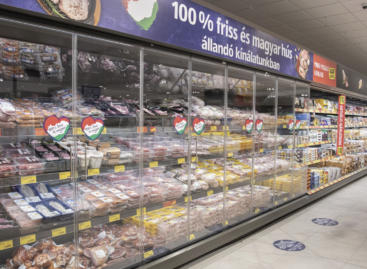Magazine: They check before they spread
Butters, margarines, butter, cheese and sandwich spreads are competing with each other for a place on the dinner table. The two biggest categories are butter and margarine – the average prices of both have increased recently, mainly due to higher ingredient prices.

Zsolt Olajos
customer marketing
manager
Upfield Hungary
According to Zsolt Olajos, customer marketing manager of margarine distributor Upfield Hungary Kft., baking margarines still make up for a large part of the margarine market; these products sell the best in the Easter and Christmas periods. He told that volume sales of private label margarines dropped in 2018 but value sales were stable. The proportion of sales realised in promotion is very high. Sales grew the most in discount supermarkets and supermarkets. Upfield will enter the market with several new products in the near future.
Butter’s price started to rise in 2017 and this trend continued in 2018 in the global market. We learned from Noémi Papp-Mile, brand manager of Foodnet Zrt. that in spite of the price increase volume sales only dropped a little in the first half of 2018, and this negative trend stopped by the end of 2018. The company’s premium product, Lurpak managed to increase its value and volume shares in the market. In product size 200-250g is still the most popular variant, but the company sees potential in larger, family-sized butters too. Ms Pap-Mile also spoke to us about shoppers buying more products in promotional periods, sometimes 2-3 butters at a time.
One of the latest trends in the Hungarian butter market is the growing importance of Hungarian manufacturers and brands.

Jaroslav Horváth
managing director
Meggle Hungary
Jaroslav Horváth, managing director of Meggle Hungary Kft. talked to Trade magazin about this situation: since Meggle butter is only made in Germany where the ingredient costs are higher, it is very difficult for the company to stay in the competition. Still, demand is increasing for their 10g and 20g butters. Mr Horváth revealed that consumer demand is growing for butters with a lower fat content than the 82-percent standard. In Europe few butter makers can manufacture products with a shelf life as long as that of Meggle products. However, this isn’t necessarily an advantage if the market is going in the direction of cheaper products. Mr Horváth opines that the Hungarian butter market will expand, as per capita consumption is three times bigger in the Czech Republic and twice as much in Slovakia.

Kitti Szalay
brand manager
FrieslandCampina Hungária
Kitti Szalay, junior brand manager of FrieslandCampina Hungária ZRt. shared information with us about the butter spread market: shoppers want new products all the time, so Milli also keeps updating its product portfolio. In addition to the popular plain, Hungarian-style and herb versions, they also offer smoked cheese, blue cheese and onion-bacon variants. The company also sells an ever-wider selection of lactose-free products, and they have launched additive-free Milli spreads too. Ms Szalay added that private label products now realise more than 40 percent of sales. This spring Mill butter spreads appear on store shelves with a more modern and characteristic packaging design.

János Volosinovszki
managing director
Nádudvari Élelmiszer
János Volosinovszki, managing director of Nádudvari Élelmiszer Kft. reported to us that sales of Nádudvari butter spread, Liptauer (‘kőrözött’) and cream cheese products had grown in 2018. These E-free products combine traditional flavours with the free-from consumer requirements of our days – they don’t contain artificial colouring, flavouring, preservatives, etc. This year they plan to launch the family-sized version of their most popular E-free product, Nádudvari Liptauer. //
Related news
Price reduction at Lidl: Popular butters are available for less
🎧 Hallgasd a cikket: Lejátszás Szünet Folytatás Leállítás Nyelv: Auto…
Read more >Another butter price cut: ALDI halved the prices of several popular butters this year
🎧 Hallgasd a cikket: Lejátszás Szünet Folytatás Leállítás Nyelv: Auto…
Read more >Together for the future – This year’s competition of the Nádudvar #mitehetüntöbbet program ends with a ceremonial award ceremony
🎧 Hallgasd a cikket: Lejátszás Szünet Folytatás Leállítás Nyelv: Auto…
Read more >Related news
How do young adults celebrate?
🎧 Hallgasd a cikket: Lejátszás Szünet Folytatás Leállítás Nyelv: Auto…
Read more >Vajda-Papír celebrates Ooops!’s 15th anniversary with a hybrid AI campaign
🎧 Hallgasd a cikket: Lejátszás Szünet Folytatás Leállítás Nyelv: Auto…
Read more >Pre-holiday shopping at up to half price
🎧 Hallgasd a cikket: Lejátszás Szünet Folytatás Leállítás Nyelv: Auto…
Read more >






